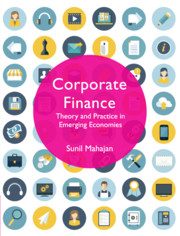Book contents
- Frontmatter
- Contents
- List of Figures
- List of Tables
- List of Corporate Snippets
- List of Abbreviations
- Preface
- Acknowledgements
- 1 Corporate Finance: A Conceptual Introduction
- 2 Financial Markets
- 3 The Time Value of Money
- 4 Capital Budgeting
- 5 Risk and Return
- 6 Valuation
- 7 Capital Structure and Financing
- 8 Dividend Payout: Policy and Practices
- 9 Leverage
- 10 Financial Derivatives
- 11 International Finance
- 12 Working Capital
- 13 Ratio Analysis
- Appendix
- Bibliography
- Index
7 - Capital Structure and Financing
Published online by Cambridge University Press: 30 April 2020
- Frontmatter
- Contents
- List of Figures
- List of Tables
- List of Corporate Snippets
- List of Abbreviations
- Preface
- Acknowledgements
- 1 Corporate Finance: A Conceptual Introduction
- 2 Financial Markets
- 3 The Time Value of Money
- 4 Capital Budgeting
- 5 Risk and Return
- 6 Valuation
- 7 Capital Structure and Financing
- 8 Dividend Payout: Policy and Practices
- 9 Leverage
- 10 Financial Derivatives
- 11 International Finance
- 12 Working Capital
- 13 Ratio Analysis
- Appendix
- Bibliography
- Index
Summary
To guess is cheap. To guess wrong is expensive.
—AnonymousTo stay where you are, as the adage goes, you need to keep running. Sustained growth is the mantra of companies. Long-term growth is possible only with continuous investment in projects. Companies can finance investment in projects either through equity or by way of debt. Being a cheaper source of funds, there is a strong temptation to rely on debt rather than on equity. But higher debt makes equity riskier and its returns more volatile. Does the mix of debt and equity have an impact on the value of a company?
Capital structure (debt–equity mix) and its impact on a company's value has, over the years, been one of the most debated and hotly contested issues in corporate finance. Work on capital structure has elevated the theory (and practice) of corporate finance to great heights and earned it the respect it never enjoyed earlier. Corporate finance, in its modern avatar, took root with the Modigliani–Miller (MM) theorem on the capital structure of companies. Capital structure theory is rich in terms of learning and debate and is the kind of stuff that makes its study worthwhile. Not only has it revolutionized the subject but also enabled the corporate sector to formulate its capital structure policy by relying on the work carried out by such luminaries as Merton Miller, Franco Modigliani, Eugene Fama, Stuart Myers, Paul Samuelson, Harry Markowitz, James Tobin, William Sharpe, Fisher Black and Myron Scholes to add value. It is only appropriate that most of these contributors were recipients of the Nobel Prize in economics for their original and outstanding work on the subject. The few who failed to get it died young; Nobel Prizes are not awarded posthumously. The option pricing model was discovered by Fisher Black and Myron Scholes in 1972. Scholes received recognition by the Nobel Committee in 1997. Unfortunately, Black had passed away a few years back and could not be awarded the prize. No one has ever believed Black's contribution to be any less than that of Scholes!
- Type
- Chapter
- Information
- Corporate FinanceTheory and Practice in Emerging Economies, pp. 176 - 213Publisher: Cambridge University PressPrint publication year: 2020



